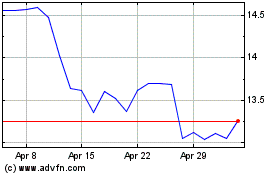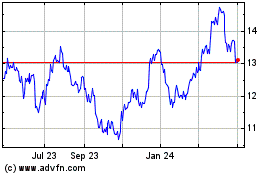Bayer's Monsanto Purchase Proceeds -- WSJ
May 30 2018 - 3:02AM
Dow Jones News
By Brent Kendall
This article is being republished as part of our daily
reproduction of WSJ.com articles that also appeared in the U.S.
print edition of The Wall Street Journal (May 30, 2018).
WASHINGTON -- The Justice Department granted antitrust approval
Tuesday to Bayer AG's planned acquisition of Monsanto Co., after
requiring the German company to sell off about $9 billion in assets
in order to preserve competition.
The department said the Bayer assets, which are being sold to
chemicals rival BASF SE, amount to the largest divestiture ever in
a U.S. merger-approval settlement. The acquisition was originally
valued at more than $60 billion.
"American farmers and consumers will continue to benefit from
competition in this industry," Justice Department antitrust chief
Makan Delrahim said.
The approval clears one of the last remaining regulatory hurdles
for the Bayer-Monsanto transaction, one of three recent megadeals
that have reshaped the global market for crop seeds and chemicals.
Last year Dow Chemical Co. and DuPont Co. merged, while China
National Chemical Corp. acquired Swiss seed and pesticide maker
Syngenta AG.
Mr. Delrahim said BASF "has the experience, financial
capabilities and the know-how to fully replace Bayer as a
competitor."
The settlement requires Bayer to sell off its businesses that
have competed directly with St. Louis-based Monsanto and other
assets designed to boost BASF as a future innovator.
Among the divestitures to BASF, Bayer will sell its cotton,
canola, soybean and vegetable seed businesses, as well as its
Liberty herbicide business, which has been a competitor to
Monsanto's Roundup product. Bayer is selling off some intellectual
property and research-and-development capabilities, as well as its
digital agriculture business, which provides data-driven farming
advice and services.
The Justice Department said that without the divestitures, the
merger would have suppressed competition for an array of seed and
crop protection products, leading to higher prices and few
choices.
The department said the asset sales also address antitrust
concerns about vertically integrating Monsanto's seeds with Bayer's
chemical seed treatments, both of which are important to
farmers.
Bayer, a pharmaceutical and chemical conglomerate, is a leading
player in the pesticide industry, while Monsanto is a market leader
in seeds and crop genes. The deal, which was announced in September
2016, would make Bayer the world's biggest supplier of pesticides
and seeds for farmers.
Bayer said it has received "almost all" regulatory clearances to
close the transaction and expects to receive any outstanding
approvals "very shortly."
The company has won antitrust approval from the European Union
after pledging similar asset sales.
Bayer Chief Executive Werner Baumann said, "Receipt of the DOJ's
approval brings us close to our goal of creating a leading company
in agriculture."
BASF said it was "delighted" with the Justice Department's
approval, while Monsanto said Tuesday's clearance by U.S.
authorities "is another important step as we work to close the
deal."
The Wall Street Journal reported last month that the Justice
Department and the companies had reached an agreement that would
allow approval of the merger.
The settlement marks the second major merger decision for the
department's antitrust division under Trump administration
leadership. The Justice Department last November filed a lawsuit to
block AT&T Inc.'s acquisition of Time Warner Inc.
In negotiations before the lawsuit, the department sought asset
sales from AT&T, but the company believed no divestitures
should be required to win approval to buy Time Warner. A federal
judge is expected to issue a decision by June 12 on whether to
allow the deal.
Write to Brent Kendall at brent.kendall@wsj.com
(END) Dow Jones Newswires
May 30, 2018 02:47 ET (06:47 GMT)
Copyright (c) 2018 Dow Jones & Company, Inc.
BASF (QX) (USOTC:BASFY)
Historical Stock Chart
From Mar 2024 to Apr 2024

BASF (QX) (USOTC:BASFY)
Historical Stock Chart
From Apr 2023 to Apr 2024
